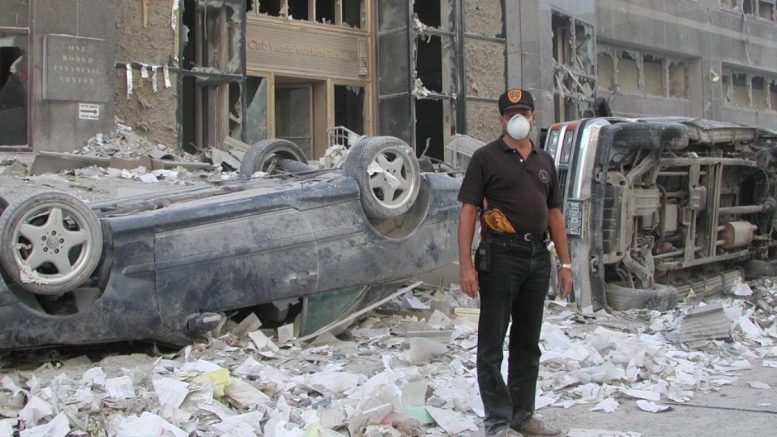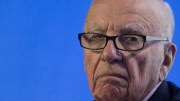David Worby’s story begins two years after hijacked planes struck the World Trade Center towers.
As tales of 9/11 heroism turned into Ground Zero medical mysteries, the White Plains lawyer started an odyssey of court battles, media frenzy and funerals.
At the time, cancers and rare diseases mounted among firefighters, police and others who spent months cleaning up Ground Zero, but authorities still disagreed with Worby’s theory that working at the site made them sick.
“Our people were wearing, at best, hospital masks of paper, so tens of thousands of people are sick as a result of the way this was handled,” Worby said during a recent interview. “It’s tragic, and it’s sad that more people are sick and dying from this than died on that actual date.”
Since 9/11, the ranks of first responders and survivors suffering from illnesses has grown steadily. Nearly 75,000 people are being monitored or treated for various conditions, according to data from The World Trade Center Health Program, which tracks the issue. That includes 5,500 cancer cases, and 27,500 other serious physical and mental health diseases.
White Plains attorney David Worby talks about representing the 9/11 first responders at his White Plains office on Tuesday, August 09, 2016. (Photo: John Meore/The Journal News)
Sitting in his office overlooking downtown White Plains, Worby spoke to The Journal News/lohud.com about how he represented 9/11 workers in the unprecedented lawsuit that linked their illnesses to toxic-chemical exposure at Ground Zero.
The case drew international attention and resulted in a nearly $1 billion settlement.
“The lesson learned here is that we can’t allow any of our leaders to say that, ‘Well, we’re tough New Yorkers and we don’t need (federal safety) protocol,’” Worby said. “It was risky behavior with dire consequences.”
What follows is one of a series of conversations with those in the Lower Hudson Valley whose lives forever changed on 9/11. The discussion has been edited for space and clarity.
White Plains attorney David Worby talks about representing the 9/11 responders.
Q: Why did you take the case ?
A: John had been the hockey coach at Fox Lane (High School in Bedford), and all my kids’ friends’ parents said, ‘Come on Mr. Worby, you write a letter.’ They just wanted to try to get him a disability payment. This wasn’t about a lawsuit. Then the city turned down a disability claim. We were running out of time and we filed a notice of claim, and somehow that got into the newspaper. The next day more calls started coming and people said, ‘Wait, there is a lawyer willing to help the sick 9/11 cops and firemen?’
Q: What happened as the case expanded ?
A: As it grew, I realized that, with all the experience I’ve had, I never handled a mass-tort action. Our firm wasn’t technologically set up with the callbacks and things like that to do something like that, and we partnered with a New York City firm. That’s when it started to get complicated, because I was the spokesperson for the firm. I was talking to The New York Daily News and New York Post, and when the nun, Sister Cindy (Mahoney), got sick and died of lung disease (in 2006) she was on the cover of the Post.
That was at the same time that I was claiming there was reduced latency periods for these leukemias and diseases because a lot of these cops and firemen had pre-existing exposures.
Q: How did you develop the claim ?
A: In other words, if you’re exposed to asbestos it could be 20 years before you get asbestosis, but if you smoke cigarettes and are exposed to asbestos it could be six or seven years less. It is the cross-accelerant behavioral theory when you’re exposed to more than one toxin.
So, at the World Trade Center site, there was asbestos, lead, mercury fragment and so many different toxins that it was a stew. At the time, the Mount Sinai Hospital people, the city and the mayor — everyone — was saying, ‘You’re not sick from this.’
Q: What changed the debate ?
A: I was with John Walcott and we were sitting in Lexington Square Cafe one night in Mount Kisco, and I said, ‘John, tell me about your exposure as a cop to smoke and toxins?’
He said, ‘Well, as a beat cop, I was going to street fires, car fires, et cetera, multiple times a month.’
I went and wrote the medical paper with only Google support because no doctor was saying these guys had pre-existing exposures. There were no buyers of my theory except for some professors up in Yale, but they didn’t exactly help the lawsuit.
But then the numbers (of victims) grew, and then we went to Washington, D.C., and lobbied (U.S. Rep.) Nita Lowey and (then-Sen.) Hillary Clinton and (Rep.) Jerrold Nadler and (Rep.) Carolyn Maloney, who was one of the first people to come to bat for all these sick people.
Q: How did the legal battle unfold ?
A: First, Ken Feinberg ran the victim’s compensation fund, but 90 percent of that went to people who were killed on that day.
Then came my lawsuit … the defense to the lawsuit was that the city was functioning under a state of emergency. The federal statues enacted an emergency protection status for the city and, during the state of an emergency they shouldn’t be liable for doing things that were slightly negligent. The argument against that was that there shouldn’t be this type of sovereign immunity forever. The emergency was over when we weren’t looking for survivors anymore after a week or so.
Q: How was it different than other cases ?
A: Your typical mass-tort is 200 people on a plane that goes down, and they all had the same thing: The plane went down, the plane is at fault and we died.
In our case we had hundreds of different illnesses, hundreds of different cancers, lung diseases, asthmas … so they couldn’t be cookie cutter, and each one had to be individually proved. That was a lengthy process, costing a fortune from all of us and taking years and years of time, and finally, in the end, our clients were ordered just a little under a billion dollars.
Q: Why was it different than the Zadroga Act ?
A: A lot of people tried to participate in my lawsuit and couldn’t. For example, the neighbors couldn’t because the people who participated in my lawsuit were protected by labor laws. Those neighbors went to the Zadroga Act for full compensation, and they’re being compensated as long as they could prove what their illness was.
That act was named after James Zadroga, who died of sarcoidosis, and it originally was enacted and being run by Sheila Birnbaum, a very powerful lawyer. They were given $2.5 billion over the course of five years. Our (clients) were still able to go to Zadroga, and they would get a credit. If I represented someone who got $100,000 in a suit against the city and their case is worth $200,000, they could get the second hundred from the Zadroga.
Q: Why was it important for Congress to extend the Zadroga Act funding ?
Three New York City firefighters raise an American flag at Ground Zero, site of the World Trade Center, on Sept. 11, 2001.
A: Because, even though the 15th anniversary is upon us, … there was 100,000 pounds of asbestos from building one and asbestosis and mesothelioma can have 20- to 25-year latency periods. So we are still looking at years of going into the future where some of these people might still get sick and deserve compensation.
Q: What else changed over time ?
A: Obviously the New York Post and Daily News apologized to me and Mount Sinai said, ‘David Worby was right.’ and I think the Daily News actually had an editorial saying that, ‘In the end, it was the work of David Worby that got these people compensated.’ Thank you Daily News.
Q: Why was the response to the 9/11 attacks on the Pentagon different from New York City ?
A: The bottom line is that the Pentagon was also attacked and thousands of people there were affected and they didn’t get sick. I didn’t know of one cancer case (at the Pentagon).
Now why is that? Because the Pentagon was run by (the U.S.) Occupational Safety and Health Administration. There were hazmat protocols, which is head-to-toe, and you go into the work site and you’re hosed down. (By contrast), people were eating lunches on the (Ground Zero) pile, and tours were being given on the pile.
Q: What lessons did you take away from the case ?
A: When there is any kind of toxic spill, it has to be handled with the utmost regard with every rule and regulation. It’s like when you’re on a scaffold in New York City. There are a lot of laws, and you can’t stand on that scaffold without being belted and without having all those other protective devices.
Q: What are some similar cases ?
A: Agent Orange had a similar arch to this. The soldiers were coming back (from Vietnam) and getting sick and the United States government was saying, ‘Come on, it couldn’t be. It’s not.’ Denial, denial, denial, which is what we faced. Then, when they start proving it, they start having presumptions and it’s gone on for a long time, and asbestos victims are cases that have gone on for a long period of time.
Q: What role does terrorism play in future lawsuits ?
A: There are people trying to sue Saudi Arabia now, and saying Saudi Arabia armed the people who downed the planes, and I know a lot of the politicians are in favor of that and permitting that litigation, thus far, to move forward. To me that is separate and apart from what we did. Our action starts after the terrorist acts. Our action starts when we were facing a disaster health-wise.
After we couldn’t save lives, there was only one thing that counted: Not the rebuilding of the site, not how fast we could clean it up, but the health, safety and welfare of hundreds of thousands of people.
Q: How did the discussion over the settlement go ?
A: Needless to say there was a lot of consternation and people saying, ‘I should be getting more.’ I can tell you, from years of handling people who’ve gotten hurt, that I represented someone who broke their arm and fell down (unrelated to 9/11). I say to them, ‘We’re recommending $40,000 here.’
They say, ‘No, I need more. I want to buy a house.’
And I say, ‘Well, that’s not the way the justice system works.’
Q: How did the case affect you ?
A: It was a substantial impact on me personally. There were people I got to know very well who died. I guess, if you’re an emergency-room surgeon, you have to really develop a thick skin, and I had to do that to continue my work because, every day, somebody was coming in sicker. And these were all young men and women. We’re not talking about people in their 60s and 70s. We’re talking about guys in their 20s and 30s. They were this sick, this early in their lives, and most of them with families.
It was very impactful and very stressful and very high pressure and very high stakes.
But it caused a lot of positive things to happen, and I would like to think, as the lawyer who started this whole thing and saw it through, that someday my grandchildren will say, ‘That was my grandfather who did that 9/11 litigation.’
Please visit the source link below to read the entire article.
www.lohud.com














